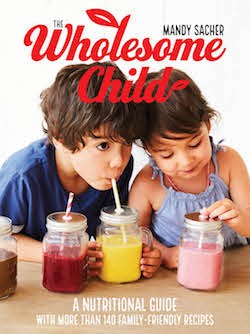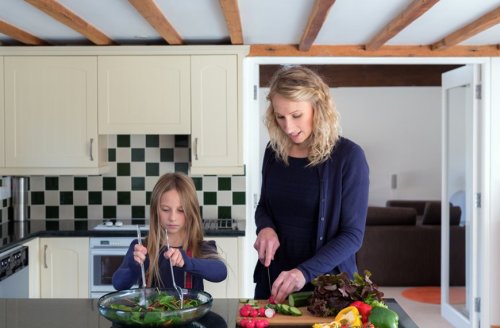Our editors independently select these products. Making a purchase through our links may earn Well+Good a commission

Planning a week’s worth of meals for yourself (and maybe a partner) is hard enough. Add kids to the mix, and it becomes an elaborate puzzle of preferences, nutritional info, schedules, and—the ultimate challenge for many families—allergies and intolerances. You hardly have enough time to squeeze a workout in, let alone shop for, prep, and cook a whole other meal for your dairy-, nut-, egg-, or gluten-adverse child.
Game-changing news: You don’t have to.
Pediatric nutritionist Mandy Sacher is full of tips on meal-prepping and feeding your fam in a way that makes everyone is happy with what’s on the table—and gets the needed nutrients, regardless of dietary sensitivities. Her new book The Wholesome Child is essentially a beautiful nutritional handbook for parents, full of recipes and tips to get even the pickiest eaters to dig in.
Here, she shares her best healthy meal-prepping tips for busy parents.
Scroll down to find out how to meal-prep for the whole family when raising a child with a food sensitivity.

Choose recipes the whole family can eat
“Something I’m very passionate about is not isolating one family member,” Sacher says. “If one child has a gluten, dairy, egg, or nut allergy or even a sensitivity, look at planning meals around that person and incorporating the whole family eating together. These days, for a lot of the allergies, there are very simple substitutions.” So, let the whole family eat chickpea spaghetti! Not only will it keep your child from feeling separate, but it will make your life a whole lot easier.
Sacher says it’s also important for a child with a food sensitivity to still eat a wide variety of meals—not just the go-tos you know are easy and won’t cause a fuss. (Translation: DIY Taco Tuesday shouldn’t have an encore performance on Wednesday, and Thursday, and…) “It’s important not to get too limited with the diet so the child is still getting all the needed nutrients,” Sachar says.
And by trying a smorgasbord of ingredients at a young age while their tastebuds are still developing, it’ll help ensure your kiddos like a wide variety of healthy foods down the road, too.

Cook in bulk to have go-to pantry staples on hand
Pro tip: Be prepared. “There are a lot of gluten, dairy, and other substitute products out there, but a lot of them are made with empty fillers,” Sacher says. Many gluten-free substitutes, for example, are made with potato starch (processed carbohydrates) and some non-dairy milks have carrageenan, which can cause digestive distress.
It’s healthier to make your own alt-flour mixes, milks, and other substitute items at home so you know exactly what’s in them. But, of course, you don’t want to have to stop everything in the middle of following a Pinterest recipe to whip up an alt-flour blend, which is why Sacher suggests making your go-to substitutions in bulk is key. “You can store a big batch of gluten-free flour in the freezer so it doesn’t go bad,” she recommends. “And if your child is intolerant to dairy, having coconut oil on hand to use in place of butter and coconut cream in place of cream or cheese are great staples to keep.”
If the problem ingredient is eggs, Sacher says one to two tablespoons of ground chia seeds, flaxseed, unsweetened applesauce, or baking soda can all be a good substitutions. And for a nut allergy, she says you can swap in seeds. “Pumpkin seed butter or sunflower seed butter will work just as well as a nut butter,” Sachar says. While pumpkin seed meal isn’t a grocery store mainstay yet, she says you can easily make your own by blending a pound of pumpkin seeds in a food processor.

Be mindful of nutrients your child may be missing
When foods like whole grains, dairy, eggs, or nuts have to be avoided, it can be easy to miss out on some key nutrients, too. Sacher says it’s important to meet with a pediatrician, dietitian, or nutritionist to get schooled on the nutrients your child will need to get in another way.
“For children who can’t have dairy, the big nutrient they are missing out on is calcium,” Sachar says. “But fortunately, there are many sources of calcium such as good-quality bone broth, sardines, salmon, tahini, sesame seeds, leafy greens, chia seed, rhubarb, black currant, and even oranges.”
If gluten is a no-go, Sacher says parents shouldn’t be too worried—so long as they’re using a variety of different whole grains like quinoa, buckwheat, amaranth. This will ensure your child is getting enough vitamin B and fiber. As mentioned before, many children with nut allergies can get the same nutritional benefits from seeds. And for eggs, you’ll need to be mindful your kid is getting protein from other sources.
Whatever it is your child is sensitive to, the key is being armed with knowledge so you can easily adapt. With easy swaps at the ready, your 1,000-piece meal-prep jigsaw will feel like child’s place.
Speaking of being prepared, here are the kitchen must-haves every healthy cook should own. Plus, 4 cooking hacks that will save you money.
Sign Up for Our Daily Newsletter
Get all the latest in wellness, trends, food, fitness, beauty, and more delivered right to your inbox.
Got it, you've been added to our email list.











